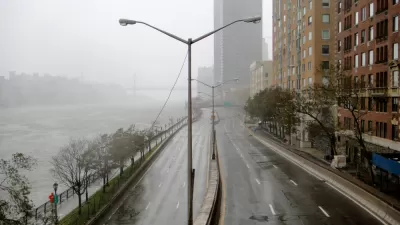Alexei Barrionuevo looks at how New York's real estate market has been impacted by the severe blackouts and flood damage from Hurricane Sandy. How long will the market for certain areas continue to feel Sandy's effects?
The last time lower Manhattan faced adversity was post-9/11, but the area recovered due to incentives to create new housing. "But the question now facing downtown New York is whether the hurricane stigma is just a short-term phenomenon, or will persist into the long term as well," says Barrionuevo. "Insurance costs are sure to rise, and lenders could become tougher on the area, mortgage brokers say, putting a damper on one of the great real estate stories in the country over the past decade."
A slew of deals to buy apartments in or near lower Manhattan have fallen through because potential buyers "thought that all of New York had succumbed to devastation," said broker Ryan Serhant, or "because of the storm they are not interested in this area anymore," said broker Frederik Eklund. A bigger issue, said Melissa L. Cohn, yet another broker, is that people who still want to buy buildings damaged by flooding cannot close deals until repairs are made, but "[n]o bank will finance in a building that has had storm damage."
"Lower Manhattan has had momentum lately, especially at the higher end of the market, where developers have been trying to cash in on the proliferation of superwealthy buyers flocking to New York," says Barrionuevo. "To compete with uptown, downtown developers have been fashioning megamansions and megapenthouses with large outdoor spaces and rooftop pools." These newer buildings have taken longer than older ones to be restored, and residents have been told that they will not be able to move back in for at least a few more months. Real estate brokers are concerned that the momentum has slowed down in Sandy's aftermath and that prices may be recalibrated to a lower level.
"Everyone, it seems, is sweating the potential for higher costs," concludes Barrionuevo. However, housing inventory in Lower Manhattan has generally been low, and while it may take time for the storm stigma to wear off, "it's hard to deny the appeal of waterfront property, especially in a city like New York." Cohn agrees, "People will come back downtown. If the property is priced properly, then they will be there."
FULL STORY: Downtown, the Crystal Ball Clouds Up

Alabama: Trump Terminates Settlements for Black Communities Harmed By Raw Sewage
Trump deemed the landmark civil rights agreement “illegal DEI and environmental justice policy.”

Study: Maui’s Plan to Convert Vacation Rentals to Long-Term Housing Could Cause Nearly $1 Billion Economic Loss
The plan would reduce visitor accommodation by 25% resulting in 1,900 jobs lost.

Planetizen Federal Action Tracker
A weekly monitor of how Trump’s orders and actions are impacting planners and planning in America.

Wind Energy on the Rise Despite Federal Policy Reversal
The Trump administration is revoking federal support for renewable energy, but demand for new projects continues unabated.

Passengers Flock to Caltrain After Electrification
The new electric trains are running faster and more reliably, leading to strong ridership growth on the Bay Area rail system.

Texas Churches Rally Behind ‘Yes in God’s Back Yard’ Legislation
Religious leaders want the state to reduce zoning regulations to streamline leasing church-owned land to housing developers.
Urban Design for Planners 1: Software Tools
This six-course series explores essential urban design concepts using open source software and equips planners with the tools they need to participate fully in the urban design process.
Planning for Universal Design
Learn the tools for implementing Universal Design in planning regulations.
Caltrans
Smith Gee Studio
Institute for Housing and Urban Development Studies (IHS)
City of Grandview
Harvard GSD Executive Education
Toledo-Lucas County Plan Commissions
Salt Lake City
NYU Wagner Graduate School of Public Service




























